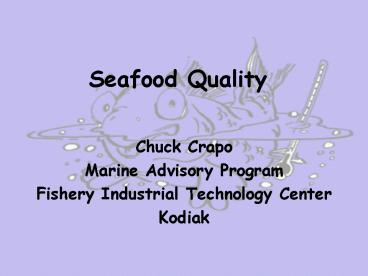Seafood Quality - PowerPoint PPT Presentation
1 / 38
Title:
Seafood Quality
Description:
Much of the effort of seafood science goes into the control of fish quality. ... Proteins: Structural-actin, myosin (70%), Sarcoplasmic globulins, enzymes (20 ... – PowerPoint PPT presentation
Number of Views:257
Avg rating:3.0/5.0
Title: Seafood Quality
1
Seafood Quality
- Chuck Crapo
- Marine Advisory Program
- Fishery Industrial Technology Center
- Kodiak
2
(No Transcript)
3
Seafood Quality
- Quality is one of the most important aspects of
seafood technology. - Much of the effort of seafood science goes into
the control of fish quality. - But What Is Quality?
4
Seafood Quality
- What is Quality?
- Production of a consistent seafood product that
is acceptable to the marketplace. - Many definitions for quality that are defined by
buyer and seller.
5
(No Transcript)
6
(No Transcript)
7
(No Transcript)
8
Types of Quality
- Intrinsic - factors that are inherent in the raw
product and essentially uncontrollable - Examples - Species
- Size
- Physiological Condition
- Parasites
- Composition
9
(No Transcript)
10
Types of Quality
- Extrinsic - quality that is influenced by outside
factors and controllable - Examples - Handling
- Storage Conditions
- Processing Factors
- Delivery Times
11
(No Transcript)
12
Muscle Anatomy
- Very simple --Consists of 2 bundles of muscle on
each side of vertebrae. Separated into upper and
lower masses. - Muscle cells run longitudinally separated by
sheets of connective tissue.
13
(No Transcript)
14
Muscle Anatomy
- Also classified as light and dark.
- Dark (cruising) muscle -
- Light (sprinting) muscle -
- Muscle type affects keeping quality since the
dark muscle is more susceptible to breakdown.
15
Composition
- Water
- Protein
- Lipid (Fat)
- Ash
- Carbohydrates
- Non-Protein Nitrogen Compounds
16
(No Transcript)
17
Role
- Water - major component, bound to the proteins
- Lipids - located in belly flaps and connective
tissue. - long chain, unsaturated fatty acids
highly susceptible to oxidation
18
Role
- Proteins Structural-actin, myosin (70),
Sarcoplasmic globulins, enzymes (20) Connective
tissue - collagen (10) - Non-Protein Nitrogen Compounds - Water soluble
chemicals. - Ammonia
- Trimethylamine oxide (TMAO)
- Amino Acids
- Nucleotides (ATP)
19
Post Mortem Changes
- Organoleptic Changes - changes in appearance,
odor texture and flavor - Rigor Mortis
- Changes in Eating Quality
20
(No Transcript)
21
Rigor Mortis
- Muscles are flexible and soft -pre-rigor.
- Muscles contract, become stiff and hard - state
of 'rigor mortis'. - Muscles relax and become flexible and soft again
- post rigor.
22
(No Transcript)
23
Rigor Mortis
- Complex reactions with ATP depletion and
accumulation of lactic acid. - High temperature rigor - failure of connective
tissue. - Quality effects - shrinking fillets, gaping,
texture changes and excessive drip loss.
24
Gaping
25
Changes in Eating Quality
- Changes in flavor compounds autolytic/ bacterial
- Phase 1 - Very fresh fish typical odor and flavor
with seaweedy, delicate flavor. - Phase 2 - Loss of characteristic odor and flavor
and neutral taste. - Phase 3 - Early signs of spoilage with slight
off-flavors such as sour, sickly sweet and
bitter. - Phase 4 - Spoiled and putrid
26
(No Transcript)
27
Autolytic Changes
- Glycogen metabolized anaerobically to produce
lactic acid until ATP is used. - ATP degrades through a series of reactions to
produce hypoxanthine. - Protein changes less severe. Cathepsins slowly
soften the tissue.
28
(No Transcript)
29
Autolytic Changes
- Very active enzymes responsible for digesting
feed such as pepsin and trypsin. - After death, enzyme slowly solubilize the organs
- stomach/intestines and then the muscle tissue
of the belly. - In heavily feeding fish, enzymes can be active
enough to "eat" through the belly wall in a few
hours causing belly burst or belly burn. Coho
salmon and winter herring are examples.
30
(No Transcript)
31
Bad
Good
32
Bacterial Changes
- Bacteria outer surfaces of fish
- Skin - 102 to 107/cm2
- Gills - 103 to 109/cm2
- Intestines - 103 to 109/cm2
- Wide range reflects environment.
33
Bacterial Changes
- Bacterial psychotrophs (cold loving)
- In live fish, muscles are sterile
- Growth occurs on gills, skin and gut.
- Punctures/breaks in the skin - bacteria invade
the muscle.
34
Softness
35
Rancidity Changes
- oxidation of lipids
- auto oxidation
- lipid hydrolysis
36
Rancidity
- Auto oxidation - incorporation of oxygen into
fat. Several distinct stages of oxidation, each
characterized by unique compounds - peroxides,
ketones, aldehydes. - Lipid hydrolysis - enzymatic action on lipids.
Lipases found in viscera and bacteria. Produces
free fatty acids that produce a soapy taste.
37
Quality
- All these processes going on make seafood very
perishable - Controlling what is possible extends the quality,
but we have limited shelf life anyway.
38
(No Transcript)































